In our second guest post, I bring you Kalani Craig’s “bad sourdough recipe.” Read it for the jokes even if you aren’t planning to make sourdough. If you missed our first guest post from “MB,” you can still catch up with “Forlorn Kale, Dejected Eggplant.”
All good sourdough recipes require three things: a starter (nursed with an incredible amount of time, patience, and freshly milled flour), a kitchen scale (for precision and predictability), and a full day of your time and motivation dedicated to kneading and proofing dough (and sometimes carving intricate patterns into it).
This recipe is not a good one. It is, however, fit for a pandemic, because A) its hard to get even the worst of flours in large quantities right now; B) my willingness to knead and proof dough for literally ever and my attention span are bad at the best of times; and C) where even is my kitchen scale?
If you’re particularly short on item B and/or are a decent baker, here’s:
the tl;dr version
- Mix 1 cup starter with 3 cups lukewarm water and ⅓ tsp yeast. Add 1 cup whole-wheat flour. Add 1 T salt. Add 5ish more cups of flour until the dough is pasty. Refrigerate until you’re ready to make bread.
- Shape a fist-sized loaf with a good flour coat. Preheat oven to 450. When the oven is preheated, put the dough in, covered with a large aluminum bowl. Bake for 30 minutes. Remove bowl, bake for 10. Let cool for 30 minutes.
The starter/bread process is a pastiche of several different recipes and several people’s techniques, combined with my inability to follow directions and a general ennui. With this version, you can sorta wing it, but if you’re not the winging it type, go look at:
- Artisan Bread in Five Minutes A Day (and their sourdough recipe)
- my friend Noah’s more specific guidelines
- my friend Kristi’s Sourdough from scratch (Hi Freddy Breddy!)
- #quarantiny and the full version
- Muddy Fork Bakery’s day-long bread-baking class
starter in 3 minutes a day
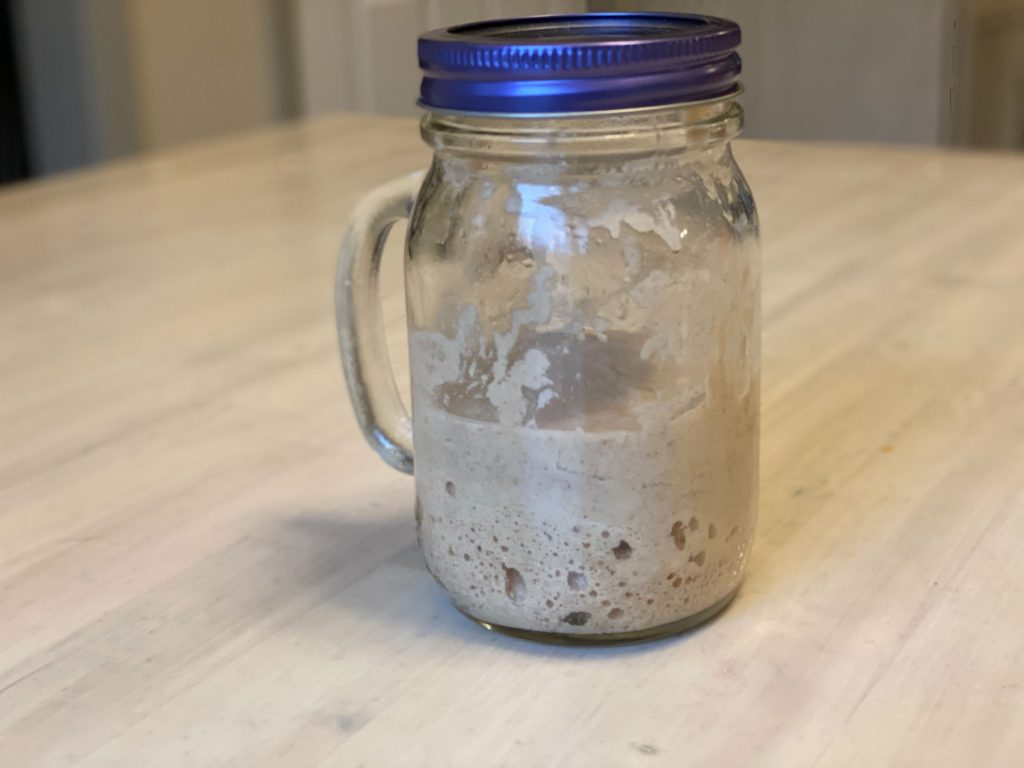
- 14 T of whole wheat flour
- 14 T of water
- A ball jar
The sourdough starter is based on #quarantiny, an Instagram starter that uses a tablespoon or so of flour per day, along with similar amounts of water. The directions for creation and feeding are pretty clear and don’t require much more than 2-3 minutes a day, but did I mention that I don’t follow directions? I had what I thought was a failed sourdough starter (several months old) in my fridge, so I kicked in a tablespoon of that too, which took my waiting time from about 14 days as seems to be the standard for a #quarantiny to about 7 days. A friend of mine trying this several time zones away added a pinch of commercial yeast to get things moving a little more quickly. One major change from all my previous sourdough-starter failures is that I used whole wheat flour, because there was an entire unopened year-old expired 5-lb bag sitting in my pantry. It didn’t smell bad, and the lesson I learned from using expired flour successfully is that lazy baking sometimes pays off. The rest of this approach spiraled from there.
Once you have a sourdough starter that doubles in size in 4-8 hours, it’s ready to use. You need around a cup(ish) of starter—more, rather than less—so make your last day’s starter feeding a ½ cup of flour and do the feeding while you’re chugging coffee in the morning.
Bad sourdough Bread in 5 Minutes a Day (with credit where it’s due)
Bread (10 minutes of mixing and shaping, spread out by some passive waiting while you eat Nutella from the jar and/or take naps):
- Sourdough starter
- A pizza stone and very large aluminum bowl (or a Dutch oven, but I like the lighter weight options)
- 3 cups water
- 6 cups flour (all purpose or bread flour; 1 cup can be whole wheat)
- ⅓ teaspoon active dry yeast
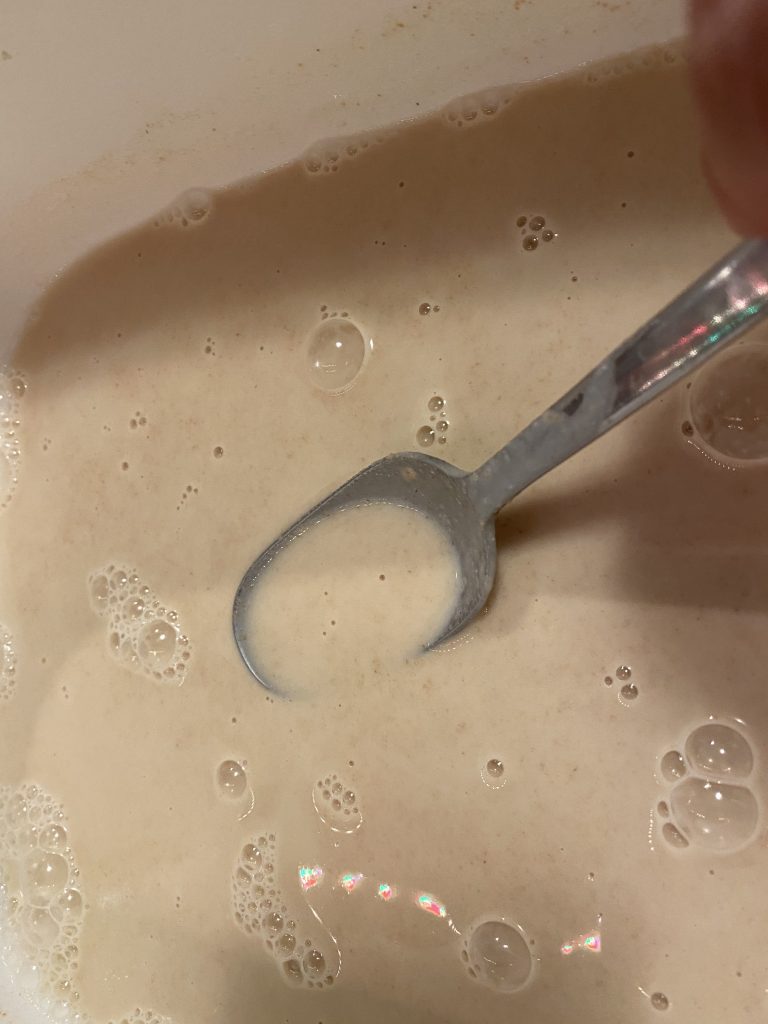
Once the starter is activated, set aside a tablespoon or two, sealed in a clean glass jar, in the fridge for the next batch. Dump the rest into a large (6-quart) plastic tub, and add a cup of lukewarm water. Mix with a fork or large spoon until the resulting swampy liquid is fairly consistent in texture. Sprinkle in ⅓ teaspoon of active dry yeast on top as insurance in case the starter is a little weak. Add 1 cup of flour—I prefer whole wheat because again no one’s buying it so it’s procurable, and honestly, I don’t even do that precise knife-cut thing my grandma taught me; I just scoop and shake until the flour is mostly even in the measuring cup—and mix. Add 2 more cups of lukewarm water and 3 cups of all purpose or bread flour, one at a time, incorporating the flour each time until it’s mostly indistinguishable from the dough.
At this point, you’ve added a cup of gloopy starter, 3 cups of water and 4 cups of flour. From here on out, we’re back to eyeballing. Our goal is to get close-ish to 6ish total cups of flour based on the ABin5 template (a little less if the first cup was whole wheat flour), but the consistency is more important. Add ½ cup at a time and incorporate until you need to use your hands to get the flour to incorporate because there’s a bunch of loose flour hanging around on the bottom of your container, but the dough still has a loose, wet consistency that’s sticky enough that you can’t get it off of your fingers. Turn the loose, sticky dough ball enough times to get all the dry flour to stick to the surface of the dough. Cover the container—I like to seal it to keep the surface from drying—and let the dough rise for at least 2 hours. It won’t double but the dry spots should be fully gone and it should start to flatten and even out on top. Timed well, the mixing can happen around 6 and you can shove the thing in the fridge before bed.
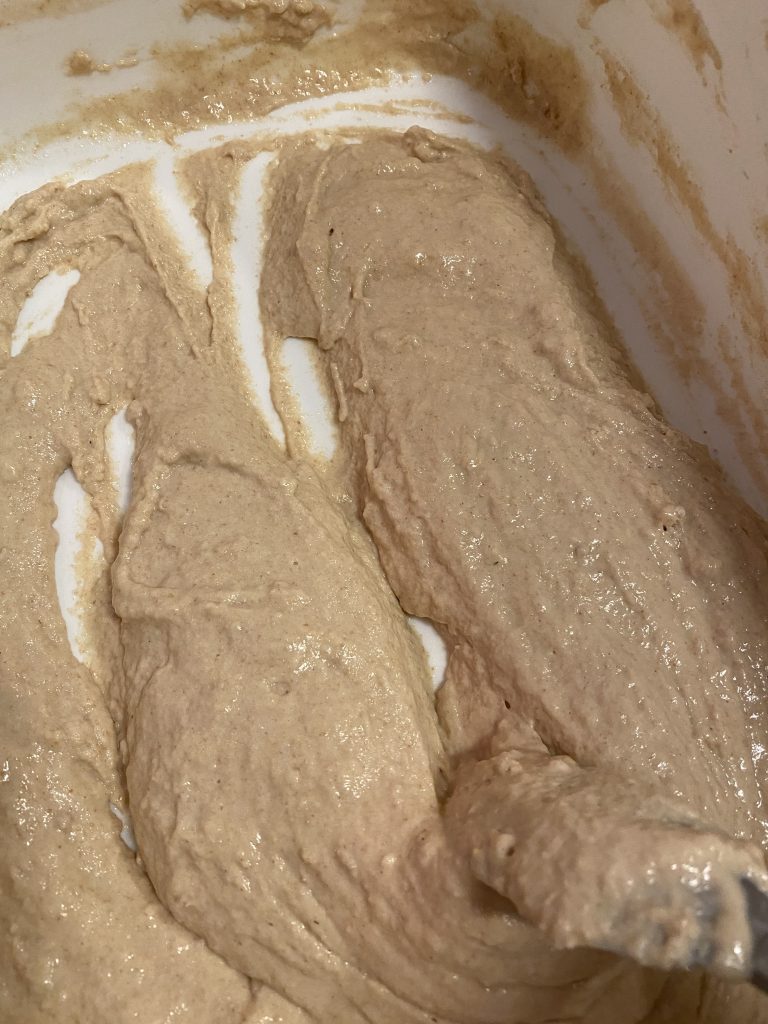
Dough after 2 cups of flour 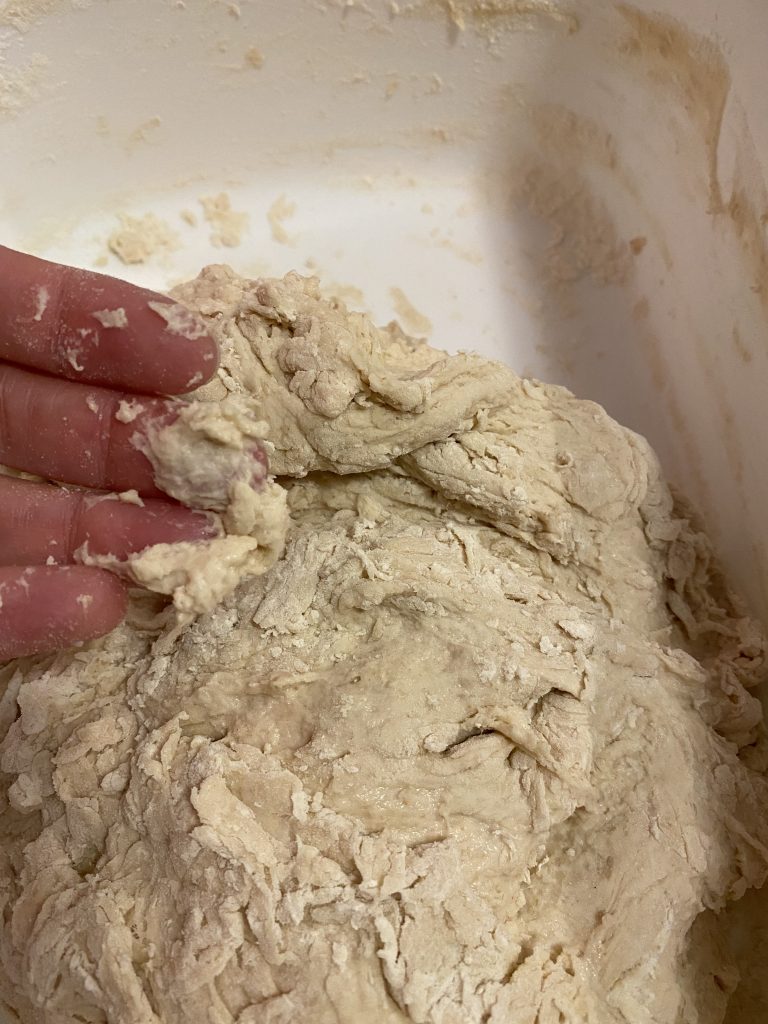
Dough after mixing 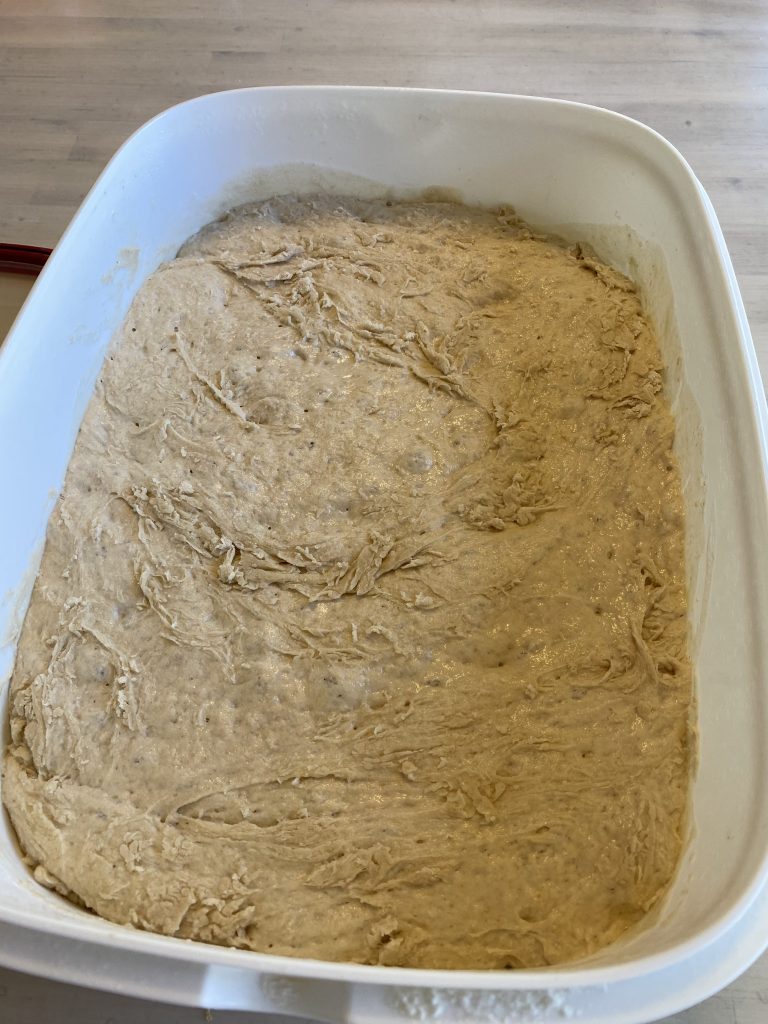
Dough after fridge
Once the dough has thought about what it did wrong overnight, it’s ready to handle. Sprinkle a good layer of flour on a cutting board (or if you’re fancy and prepared, cornmeal, but again, who are we kidding). Pull off a hunk of the dough, sprinkle the top of the ball with a good coating of flour and gently fold the floured exterior around the rest of the dough ball until it’s smooth and round (for a boule) or smooth and sorta weirdly oblong (for smaller slices on a longer loaf). Let it sit for 2-ish hours at room temperature.
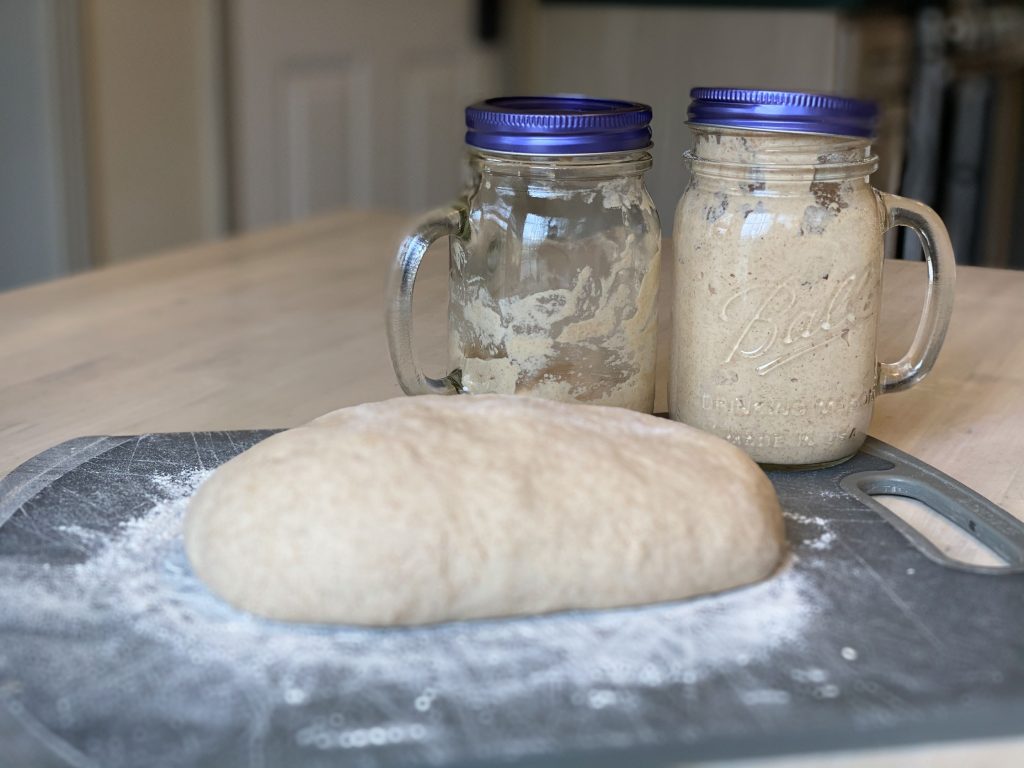
About 30 minutes before you’re ready to bake, preheat the oven to 450 with your pizza-stone-adjacent cooking surface inside. Once the preheat is done, throw a nice dusting of flour onto the surface of your now-wobbly dough again, smooth it out, and use a nice sharp knife to ruin it with a few 1/2” deep slashes that will help the dough rise. Transfer the nascent bread to your preheated flat surface and put your giant aluminum bowl upside down over your future sandwich; this traps steam from the dough and helps set the crust. Bake for 30 minutes. Remove the very very hot bowl, putting it in a place where your very very curious cats will not try and touch it with their bare paws, and bake for an additional 10 minutes.
Remove, but do not eat (yet). Instead, pay homage to the sourdough bread that you just made from scratch by eyeballing stuff and ignoring millenia of kneading and proofing tradition. Listen to its crackling crust, admire its form and inhale its beauty, but don’t cut into it for 30-40 minutes or the moisture inside will escape in all the wrong ways and you’ll have a lovely crackly crust wrapped around a gross ball of sticky gluten.
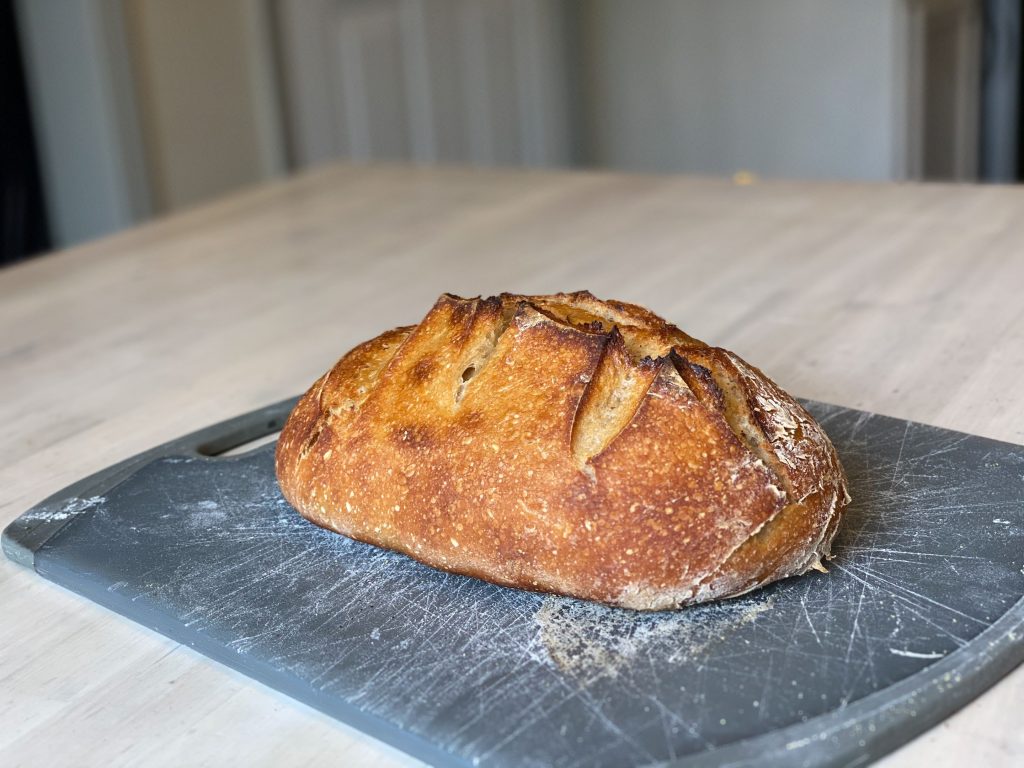
I time the baking so the shaping happens around 9, the baking starts at 11, and we can cut into a warm loaf of bread at noon-ish. Yes, this means popping into the kitchen for 2 minutes a few times over the course of the morning but OMG we are literally always at home and what else is going to motivate me to get up out of my office chair? Not in a pandemic, the rising/baking process works best at night for bread the next day. An uncut crust keeps the center (“crumb”) pretty fresh for 24-36 hours and it’s still tasty at 48.
1 comment on A Bad Sourdough Recipe